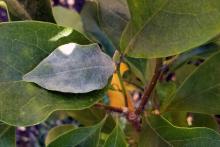Cause The fungus Erysiphe magnifica (formerly Microsphaera magnifica) has been reported from Washington and powdery mildew has been observed on magnolia in Oregon. The Magnolia collection of the Washington Park Arboretum, University of Washington, Seattle, includes 34 species and M. liliiflora was the only species on which powdery mildew was observed in 2003.
Symptoms Obvious white patches of mycelium occur on both sides of infected leaves. By late September, infected plants of M. liliiflora can be defoliated.
Cultural control
- Space plants for good air circulation.
- Remove and destroy fallen leaves.
Chemical control
- Banner MAXX at 5 to 8 fl oz/100 gal water. Group 3 fungicide. 12-hr reentry.
- Concert at 22 to 35 fl oz/100 gal water. May cause injury to buds, blooms or tender new growth. Landscape use only. Group 3 + M5 fungicide. 12-hr reentry.
- Heritage at 1 to 4 oz/100 gal water plus a non-silicone-based wetter sticker. Group 11 fungicide. 4-hr reentry.
- Seido at 4 to 5 fl oz/100 gal water plus an adjuvant. Group 50 fungicide. 4-hr reentry.
- Tourney EZ at 1 to 4 oz/100 gal water. Group 3 fungicide. 12-hr reentry.
Reference Glawe, D. A. 2003. First report of powdery mildew of Magnolia caused by Microsphaera magnifica (Erysiphe magnifica) in the Pacific Northwest. Plant Health Progress doi:10.1094/PHP-2003-0512-02-HN.

